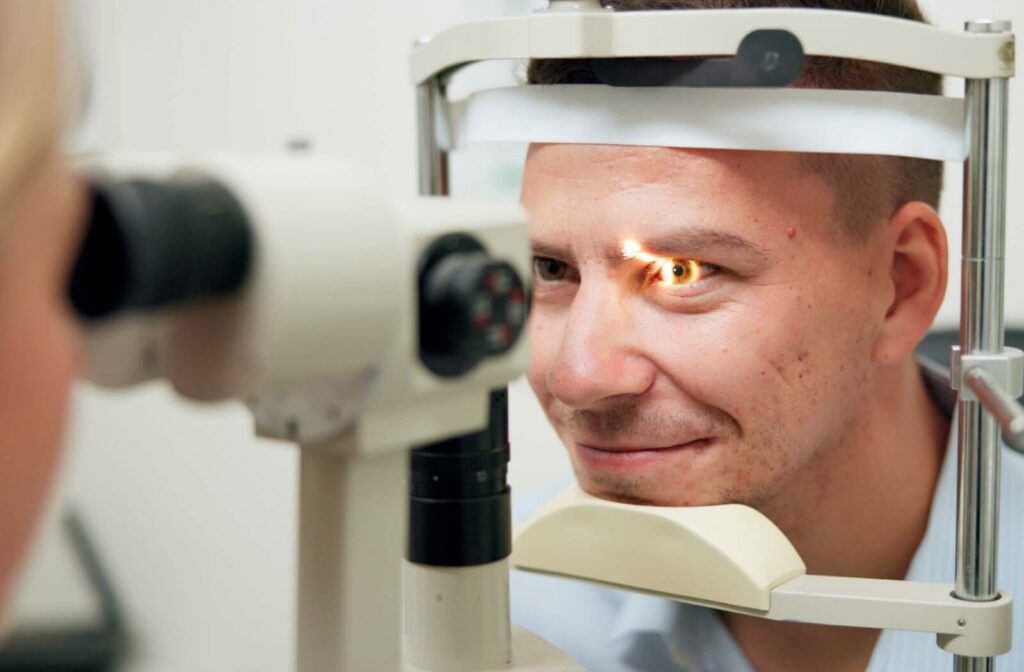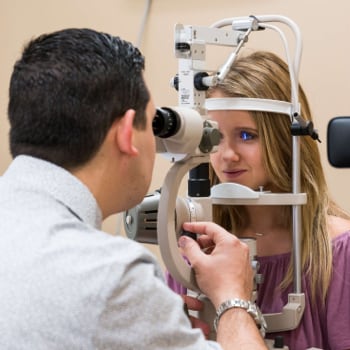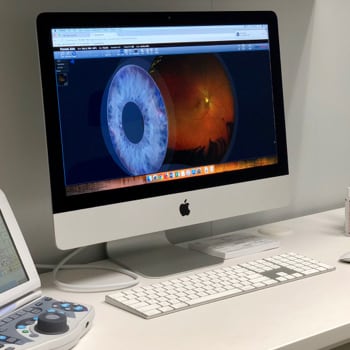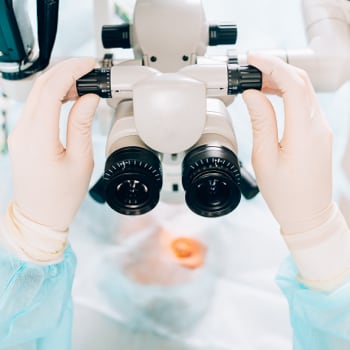If you have diabetes, you already have a lot to think about. Maintaining your eye health still needs to be a top priority among all the managing you already have to do. A diabetic eye exam is a specialized check-up designed to evaluate the internal health of your eyes, detect potential issues early, and protect your vision in the long run.
Diabetes can have far-reaching impacts on your overall health, but its effects on your eyes often go unnoticed until significant damage occurs. A trip to your optometrist is one of the best ways to stay ahead of this all too common condition!
How Diabetes Impacts Your Eye Health
Diabetes is a chronic condition that can cause long-term health problems, especially if left unmanaged. Every year, 1.2 million Americans are diagnosed with diabetes, joining the millions who already have it.
It occurs when your body either doesn’t produce enough insulin (Type 1) or cannot effectively use insulin (Type 2). Since insulin helps regulate blood sugar levels, a lack of it causes sugar to build up in the bloodstream, leading to potential complications throughout your body—including your eyes.
Some common eye conditions linked to diabetes include:
- Diabetic retinopathy: High blood sugar levels can damage the small blood vessels in the retina. These damaged vessels may leak, swell, or become blocked, leading to vision loss. Over time, new and fragile blood vessels may grow, causing additional complications.
- Diabetic macular edema: This condition develops when the damaged blood vessels in the retina leak fluid, causing the macula (the part of your retina responsible for sharp central vision) to swell. This can significantly affect your ability to see fine details.
- Glaucoma: People with diabetes are about twice as likely to develop glaucoma. This condition occurs when pressure builds up in the eye, damaging the optic nerve.
- Retinal detachments: Sometimes, scar tissue from diabetic retinopathy can pull on the retina, causing it to detach from the back of the eye. This requires immediate attention to prevent permanent vision loss.
While some eye conditions related to diabetes develop silently, others may present symptoms worth noting. These include:
- Blurry or fluctuating vision
- Flashes of light or floaters in your vision
- Sudden or gradual vision loss
- Pain or pressure in the eye
Even if you’re not noticing any of these symptoms, it’s important to stay proactive about your eye health through regular diabetic eye exams.
What Is a Diabetic Eye Exam?
A diabetic eye exam is not your typical eye test. It’s a detailed evaluation tailored specifically to detect changes or damage caused by diabetes. During the exam, your optometrist focuses on assessing the health of your retina, optic nerve, and blood vessels.
To achieve this, your optometrist may dilate your pupils using special eye drops. This allows us to have a broader view of the eye’s internal structures that wouldn’t be visible during a standard eye exam. By detecting potential issues early, diabetic eye exams play a pivotal role in preventing severe complications, such as vision loss.
Doctors recommend that anyone with diabetes get this exam at least once a year. Staying consistent with these appointments gives your eye doctor the chance to monitor any changes over time and intervene before problems progress.
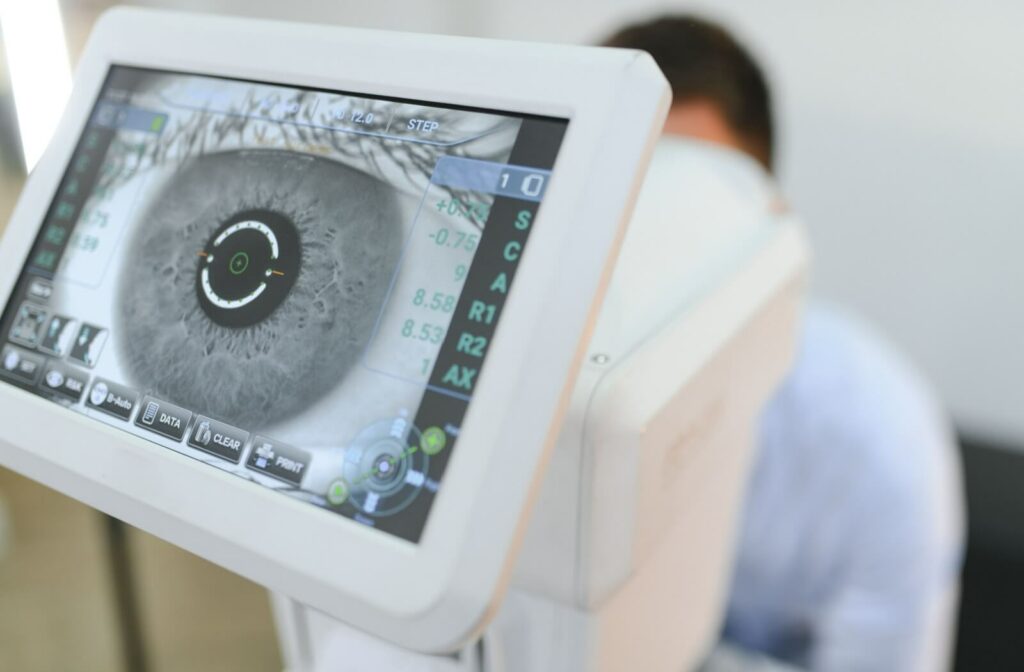
What to Expect During a Diabetic Eye Exam
Diabetic eye exams don’t have to be a mystery, and they’re a lot like the eye exams you’ve already had—just with a couple of extra steps to focus on what matters. Here’s what you can generally expect:
Preparation
Your exam will likely begin with an assessment of your eye pressure using a tonometry instrument to check for signs of glaucoma. Depending on your history, your optometrist might also perform a visual field test to evaluate your peripheral vision.
Pupil Dilation
Dilating drops may be used to widen your pupils. While the drops can temporarily blur your vision and make you more sensitive to light, the process is gentle and typically painless. We recommend bringing sunglasses and a companion to drive you home, as the effects can last several hours.
Advanced Imaging
Advanced imaging techniques such as Optos Ultra-Wide Field (UWF) and Optomap retinal imaging are recommended. These tools provide invaluable insights into the condition of your retina, optic nerve, and blood vessels
Comprehensive Examination
Using a slit lamp and ophthalmoscope, your optometrist will conduct a thorough evaluation of your eyes’ internal health. We’ll look for common diabetic eye problems like retinopathy, macular edema, and early signs of glaucoma. By detecting potential issues early, we can recommend timely interventions to protect your vision.
Follow-Up and Recommendations
After reviewing the imaging results, your optometrist will discuss their findings with you and answer any questions you might have. If necessary, we may suggest treatments, lifestyle adjustments, or follow-up appointments to manage your eye health effectively.
See the Difference with Diabetic Eye Exams
For those living with diabetes, annual eye exams are a vital step in protecting long-term vision. Even when you’re managing your blood sugar well, certain diabetic eye conditions can develop quietly. These exams help optometrists identify and address issues before they escalate, so you can stay in control of your health.
There’s no time like the present to schedule your appointment at Great Hills Eye Care! Our experienced optometrists are ready and excited to help you protect your vision. Enjoy the peace of mind that comes with proactive care.
Book now and see how we make great eye care fit your life.

